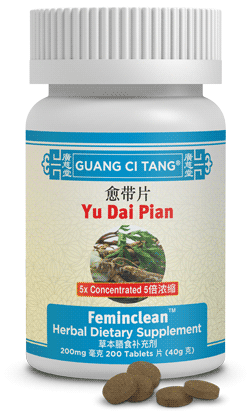How To Support Vaginal Health With TCM

You’ve heard of the gut microbiome, the invisible world of trillions of bacteria that reside in the colon. But there’s another anatomical microbiome, the health of which should be of paramount importance for all women: the vaginal microbiome.
A balanced vaginal microbiome, just like the gut microbiome, contains an overwhelming majority of friendly bacteria. But because of various factors including lifestyle choices, the number of unfriendly bacteria in the vaginal tract can multiply fast.
Here’s what women need to know about supporting vaginal health with TCM (traditional Chinese medicine) and from a western medicine perspective.
Vaginal Microbiome Dysbiosis
A healthy gut microbiome contains approximately 85% friendly bacteria and 15% potentially-harmful bacteria. With that delicate balance, the immune system gets enough of a workout to keep pathogenic bacteria in check. But when gut dysbiosis occurs, the percentage of unfriendly bacteria can skyrocket. The same is true of vaginal dysbiosis. Like the large intestine (colon), the vaginal canal is also a major settlement for microorganisms.
When pathogenic microorganisms flourish in the vaginal canal, itching, burning and colored discharge may result. In Western medicine, the opportunistic fungus, Candida albicans is most often the underlying cause of vaginal discharge.
In light of this fact, Candida albicans has a negative connotation; it’s responsible for infections. But the truth is, this yeast (yeast is a type of fungus) is part of a normal microbiome, both in the gut and in the vaginal canal. The problem arises when the body is under stress. That’s when Candida albicans can multiply out of control.
How Does Western Medicine Treat Vaginal Discharge?
Most often, antibiotics are the first treatment option. However, just like with gut health, antibiotics can destroy the microbiome of the vaginal canal. Of course, there are times when antibiotics are absolutely necessary and potentially life-saving. But the downside to antibiotics—especially the overprescribing of them—is that much of the good bacteria is destroyed along with the bad. Furthermore, the overuse of antibiotics and antifungals for vaginal discharge has led to the harmful microorganisms becoming resistant to these interventions.
What Causes Vaginal Discharge?
So we know that Candida albicans is the fungal overgrowth responsible for the abnormality. But what causes the overgrowth in the first place? There are several things that can cause it. Let’s start with one of the leading culprits in western civilization: diet.
The overconsumption of gluten, which is the protein molecule in wheat and other grains, may be one factor. Thus, if you’ve experienced several episodes of vaginal discharge over the years and your diet is high in products with wheat, wheat flour and other sources of gluten (beer, rye, barley), one resolution is to try a gluten-free diet. Consuming too much sugar can also create vaginal dysbiosis.
There’s also an association between birth-control pills and this health concern. That’s because contraceptives may lead to higher levels of estrogen in the body. This in turn can make yeast overpopulate and stick to the vaginal walls more easily.
Stress to the body of any kind, be it poor diet or failing to manage emotional or mental stress, can lead to vaginal dysbiosis.
How Does TCM Explain Discharge?
No matter what the root cause is from a Western perspective, in TCM, there are two diagnostic patterns that give rise to vaginal dysbiosis:
- Spleen Qi Deficiency
- Damp-Heat
An interesting study published in Evidence-Based Complementary and Alternative Medicine examined vaginal secretions that were collected from patients with discharge and also from women with no abnormal discharge. The purpose of the study, conducted using RNA sequencing methods, was to differentiate discharge between Spleen Qi Deficiency and Damp-Heat.
The researchers learned that Streptococcus was the dominant microbiota in patients with Spleen Qi Deficiency, while those prone to Damp-Heat are more likely to exhibit an overabundance of Prevotella.
“These findings can provide a new approach to acquire a scientific understanding of the syndromes of TCM, which in turn would benefit the development of personalized medicine, in terms of ancient medicine and complex biological systems.”
So how can you tell whether you may have Spleen Qi Deficiency or Damp-Heat? In TCM tongue diagnosis, with the former, the tell-tale signs are a pale tongue with teeth marks (red dotted) and white coating; with Damp-Heat, the tongue-coating appears bright red with a yellow, greasy coating.
Vaginal discharge is a normal physiological function, and its source comes from the Kidneys, which also houses the essence of the body, or Jing. All bodily matter, vaginal discharge included, is controlled by Jing. But it’s the Spleen organ system that is in charge of normal or abnormal discharge. That’s because the Spleen channel is responsible for the transformation of vaginal discharge.
Thus, if one has a deficiency of Qi in the Spleen, there is simply not enough energy to process the discharge in a healthy manner.
Vaginal Health With TCM
Excessive discharge is not a modern phenomenon. For at least a few thousand years, women in the Far East have used Chinese herbs for feminine hygiene. One such time-tested formula is Yu Dai Pian, or Feminclean, which is formulated to drain dampness and clear heat. In addition to these actions, Feminclean supports a healthy vaginal environment by nourishing Yin energy and tonifying the Blood.
Finally, supporting vaginal health with TCM will only go so far if you eat a diet high in sugar. Excess sugar feeds pathogenic yeast that gives rise to dysbiosis in the vaginal microbiome.







